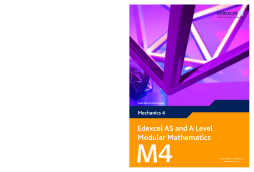
Additional Information
Book Details
Abstract
Edexcel's own course for the GCE specification. Providing the best match to the specification, this book motivates students by making maths easier to learn. Written by chief examiners, it provides student-friendly worked examples and solutions, leading to a wealth of practice questions. Sample past exam papers are included for thorough exam preparation, and regular review sections help to consolidate learning. Opportunities for stretch and challenge are presented throughout the course, and an interactive FREE LiveText CD-ROM contains everything students need to motivate and prepare themselves. The all new Exam Cafe gives students revision advice, key ideas summaries and an abundance of exam practice, with hints and tips.
Table of Contents
| Section Title | Page | Action | Price |
|---|---|---|---|
| Cover | Cover | ||
| Contents | ii | ||
| About this book | iv | ||
| Chapter 1: Relative motion | 1 | ||
| 1.1: Relative displacement | 2 | ||
| 1.2: Problems involving relative velocity | 3 | ||
| 1.3: Problems involving water current and wind effects | 4 | ||
| 1.4: Problems involving one body intercepting (or colliding with) another body | 9 | ||
| 1.5: Problems involving closest approach | 13 | ||
| 1.6: Problems involving setting a course to achieve closest approach | 18 | ||
| Summary of key points | 23 | ||
| Chapter 2: Elastic collisions in two dimensions | 24 | ||
| 2.1: Problems involving the oblique impact of a smooth sphere with a fixed surface | 25 | ||
| 2.2: Problems involving the oblique impact of two smooth spheres | 30 | ||
| Summary of key points | 40 | ||
| Chapter 3: Resisted motion of a particle moving in a straight line | 41 | ||
| 3.1: Using calculus when a particle moves in a straight line against a resistance which varies with the speed of the particle | 42 | ||
| 3.2: Modelling the resistance to an object moving in a straight line under gravity using functions of velocity | 48 | ||
| 3.3: Using calculus when a particle, with an engine working at a constant rate, moves in a straight line against a resistance which varies with the speed of the particle | 55 | ||
| Summary of key points | 60 | ||
| Review Exercise 1 | 61 | ||
| Chapter 4: Damped and forced harmonic motion | 73 | ||
| 4.1: Investigating the motion of a particle which is moving under the influence of a restoring force proportional to the particle’s displacement and a resistance which is proportional to its speed | 74 | ||
| 4.2: Investigating the motion of a particle which is subject to the same two forces as in the previous section but is also forced to oscillate with a frequency other than its natural one | 82 | ||
| Summary of key points | 90 | ||
| Chapter 5: Stability | 91 | ||
| 5.1: Using potential energy to find positions of equilibrium and to test for stability | 92 | ||
| Summary of key points | 101 | ||
| Review Exercise 2 | 102 | ||
| Examination style paper | 113 | ||
| Answers | 115 | ||
| Index | 119 |
